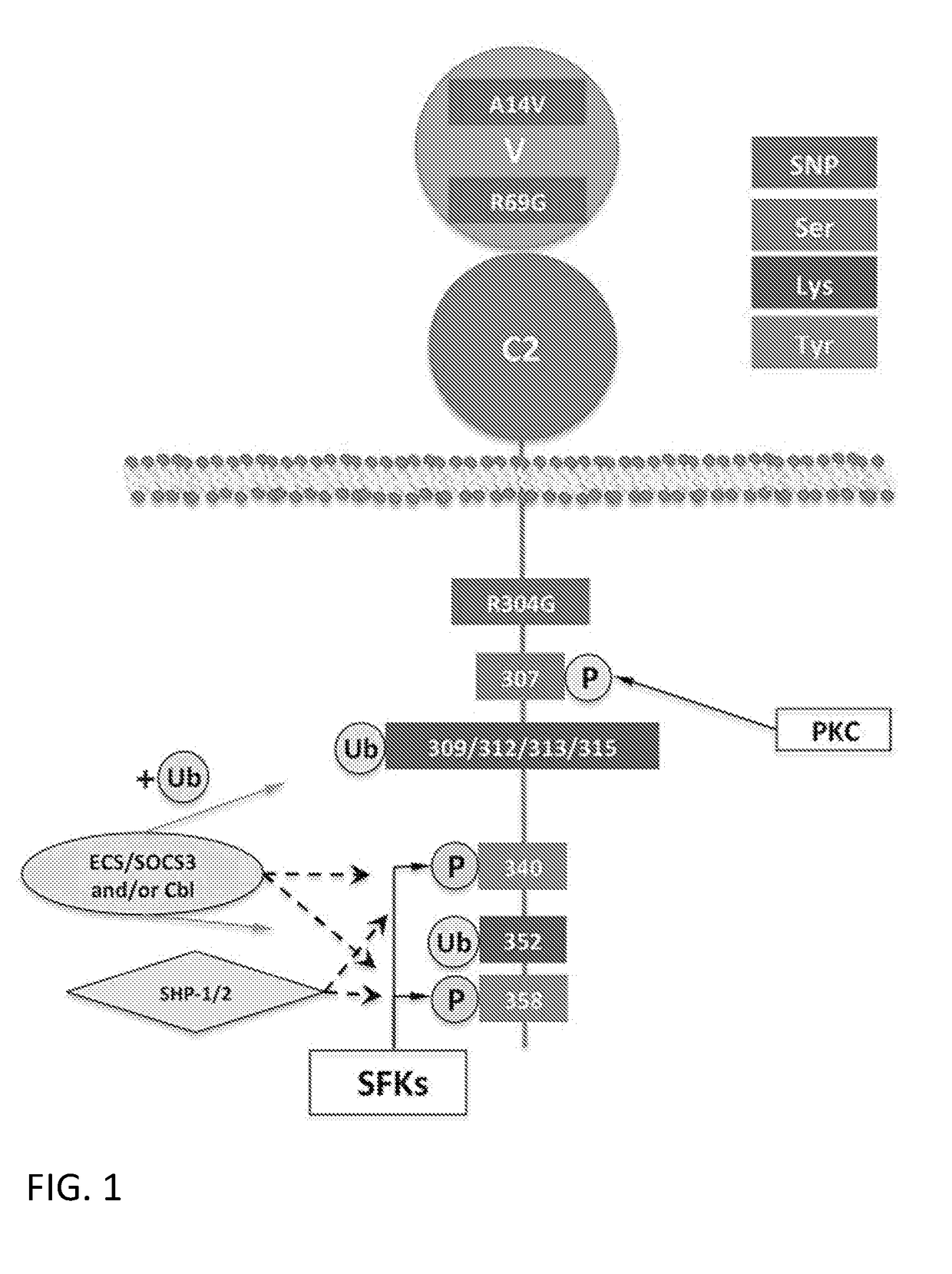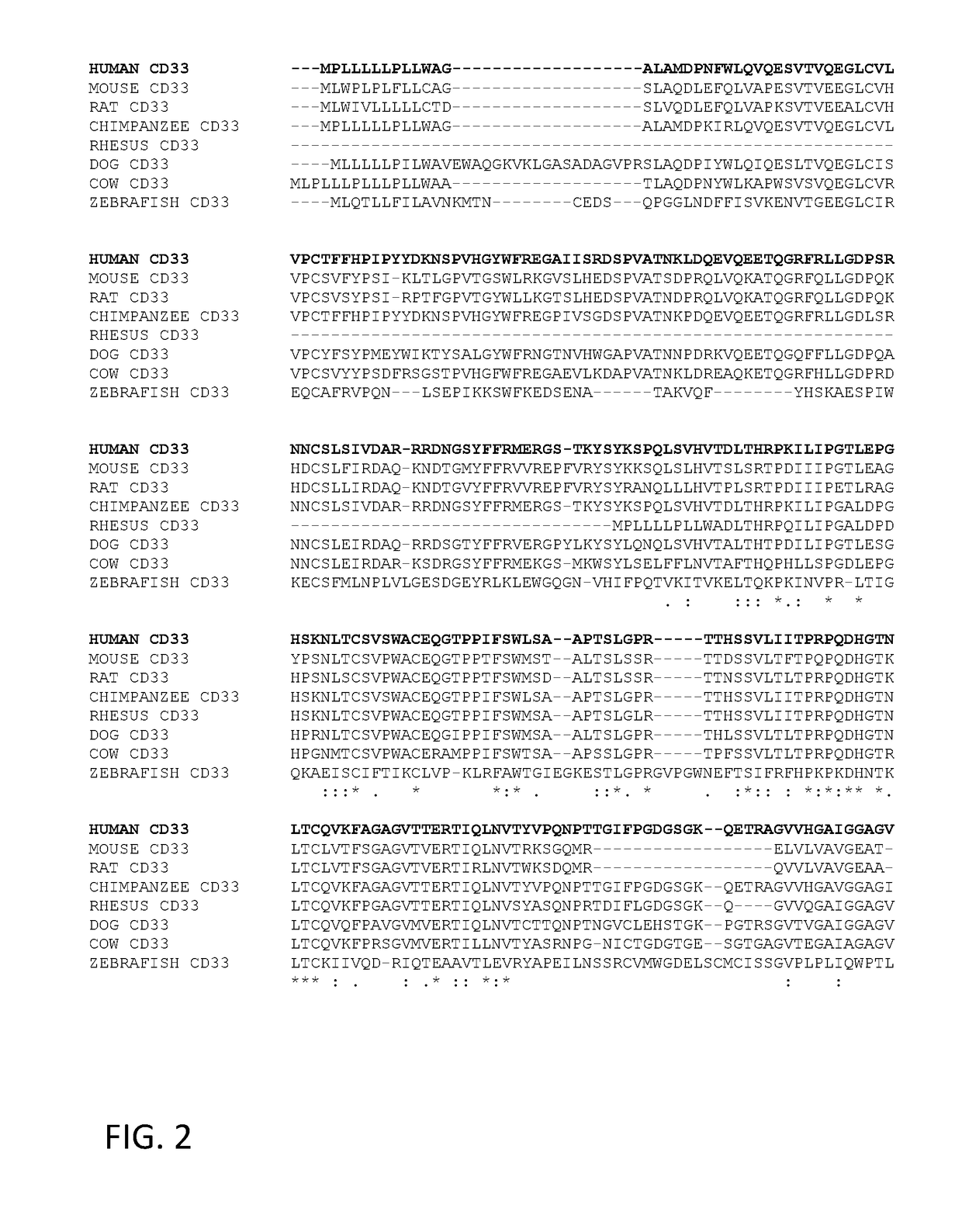Anti-cd33 antibodies and methods of use thereof
a technology of anti-cd33 antibodies and antibodies, which is applied in the field of anti-cd33 antibodies, can solve the problems of no data reported on the ability of anti-cd33 antibodies to downregulate cd33, block cd33 ligand/receptor interactions, and no data reported on the ability of anti-cd33 antibodies, so as to promote the survival, function, or proliferation of one or more immune cells, and reduce risk. , the effect of promoting
- Summary
- Abstract
- Description
- Claims
- Application Information
AI Technical Summary
Benefits of technology
Problems solved by technology
Method used
Image
Examples
example 1
n, Identification, and Characterization of Anti-CD33 Antibodies
Introduction
[0533]The amino acid sequence of human CD33 is set forth below in SEQ ID NO:1. Human CD33 contains a signal sequence located at amino acid residues 1-17 of SEQ ID NO:1, an extracellular immunoglobulin-like variable-type (IgV) domain located at amino acid residues 19-135 of SEQ ID NO:1, an Ig-like C2-type domain located at amino acid residues 145-228 of SEQ ID NO:1, a transmembrane domain located at amino acid residues 260-282 of SEQ ID NO:1, an ITIM motif 1 located at amino acid residues 338-343 of SEQ ID NO:1, and an ITIM motif 2 located at amino acid residues 356-361 of SEQ ID NO:1. The structure of CD33 is depicted in FIG. 1. Alignment of a portion of CD33 with CD33 homologs is shown in FIG. 2.
[0534]CD33 amino acid sequence (SEQ ID NO:1):
10 20 30 40 50 60MPLLLLLPLL WAGALAMDPN FWLQVQESVT VQEGLCVLVP CTFFHPIPYY DKNSPVHGYW 70 80 90 1...
example 2
apping of CD33 Antibodies
[0566]CD33 antibodies were tested for their ability to bind 15 or 25-mer peptides spanning the entire human CD33. The CD33 antibodies were also compared to a reference CD33 antibody by determining their CD33 binding region.
[0567]Methodology
[0568]Linear 15-mer peptides were synthesized based on the sequence of human CD33 (SEQ ID NO:1), with a 14 residue overlap. In addition, linear 25-mer peptides were synthesized based on sequence of human CD33 (SEQ ID NO:1) or mouse CD33 (SEQ ID NO:2) with a single residue shift. The binding of CD33 antibodies to each of the synthesized peptides was tested in an ELISA based method. In this assay, the peptide arrays were incubated with primary antibody solution (overnight at 4° C.). After washing, the peptide arrays were incubated with a 1 / 1000 dilution of an antibody peroxidase conjugate (SBA, cat. nr. 2010-05) for one hour at 25° C. After washing, the peroxidase substrate 2,2′-azino-di-3-ethylbenzthiazoline sulfonate (ABTS...
example 3
body-Induced Decrease in Cell Surface Levels of CD33 In Vitro and In Vivo
[0589]In Vitro Expression of CD33
[0590]The purpose of the following Example was to test whether anti-CD33 and / or CD33 bispecific antibodies reduce the cell surface level of CD33 on monocytes, macrophages, dendritic cells, neutrophils, T cells, and / or microglia.
[0591]The ability of anti-CD33 antibodies to reduce cell surface levels of CD33 on the histiocytic lymphoma cell line U937, as well as human primary monocytes, human primary dendritic cells (DC) derived from peripheral blood monocytes, human primary macrophages derived from peripheral blood monocytes, and human primary microglial cells derived from human monocytes was evaluated.
[0592]Human microglial cells were prepared from peripheral blood monocytes by culture in serum-free RPMI with 1% Pen / Strep, 10 ng / ml GM-CSF, 10 ng / ml M-CSF, 10 ng / ml beta-NGF, 100 ng / ml CCL-2, 100 ng / ml IL-34 according to protocols described in Etemad et al., JI (2012), and Ohgidan...
PUM
| Property | Measurement | Unit |
|---|---|---|
| temperature | aaaaa | aaaaa |
| dissociation constant | aaaaa | aaaaa |
| temperature | aaaaa | aaaaa |
Abstract
Description
Claims
Application Information
 Login to View More
Login to View More - R&D
- Intellectual Property
- Life Sciences
- Materials
- Tech Scout
- Unparalleled Data Quality
- Higher Quality Content
- 60% Fewer Hallucinations
Browse by: Latest US Patents, China's latest patents, Technical Efficacy Thesaurus, Application Domain, Technology Topic, Popular Technical Reports.
© 2025 PatSnap. All rights reserved.Legal|Privacy policy|Modern Slavery Act Transparency Statement|Sitemap|About US| Contact US: help@patsnap.com



